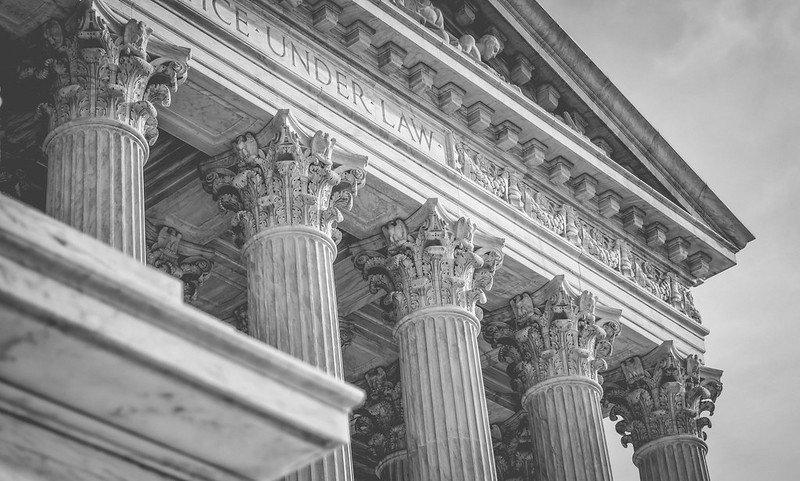
Supreme Court Watch
Argued November 7, 2023
Question Presented
Does 18 U.S.C. § 922(g)(8), which prohibits the possession of firearms by persons subject to domestic violence restraining orders, facially violate the Second Amendment?Statement of Facts and Procedural History
Zackey Rahimi was convicted of possessing a gun while subject to a domestic violence protective order. This protective order was issued after he assaulted his partner in a parking lot and fired a weapon upon seeing people witness that event. In late 2020 and early 2021, Rahimi was involved in multiple additional violent incidents in the Arlington, Texas, region, which included the discharge of firearms. Rahimi was placed under a civil protective order for an alleged assault against his ex-girlfriend in February 2020, which prohibited him from possessing guns. After a police search of his home after identifying Rahimi as a suspect in a series of shootings, police found a rifle and pistol in his possession, which led to his indictment under 18 U.S.C. § 922(g)(8), which makes it unlawful for someone under a domestic violence protective order to possess firearms.Mr. Rahimi challenged 18 U.S.C. § 922(g)(8)as a violation of the Second Amendment’s right to keep and bear arms. The Fifth Circuit Court of Appeals invalidated the statute on its face, holding that individuals subject to domestic violence protective orders maintain a constitutional right to bear arms. Under the Bruen standard, the court found no sufficiently analogical law in early American history for such a deprivation of the right to bear arms.
Summary of Argument
Solicitor General Elizabeth Prelogar represented the United States and argued that the 5th Circuit’s ruling would cause destabilizing consequences across the nation. Prelogar noted that in Bruen, the Court recognized that Congress can take away guns from people who are not responsible, law-abiding citizens, such as loyalists in the Revolutionary War period. Under Prelogar’s argument, § 922(g)(8) simply applied the principle that dangerous people can be disarmed, which is rooted in the history and tradition of our nation’s practice of firearm regulation.
- Matthew Wright, counsel for Rahimi, argued that § 922(g)(8)’s provision outlawing possession of firearms was in clear violation of the Second Amendment, and Bruen’s test failed because there was no early American practice of banning the possession of weapons in response to domestic violence. Thus, Wright argued that § 922(g)(8) violates the Second Amendment on its face.
Key Precedents
- District of Columbia v. Heller, 554 U.S. 570 (2008)
- The Court held that Washington, D.C.’s ban on lawful firearm possession in the home for self-defense violated the Second Amendment’s guarantee of an individual right to “possess and carry weapons in case of confrontation.” The Court further held that the Second Amendment confers an individual right to possess a firearm to law-abiding citizens without the need for a connection to military service, although the Court also noted that the Second Amendment was not an unlimited right.
- McDonald v. City of Chicago, 561 U.S. 742 (2010)
- The Court held that the Second Amendment protected the right of private individuals to keep and bear arms in the home for the purposes of self-defense, and the Second Amendment’s protections are fully incorporated into the states via the 14th By affirming that the Second Amendment was incorporated to the states in the same way as the rest of the Bill of Rights, the Court attached decades of substantive due process jurisprudence to the Second Amendment and restricted the states from infringing on their citizens’ constitutional exercise of their Second Amendment rights, such as keeping arms in the home for self-defense.
- New York State Pistol & Rifle Association Inc. v. Bruen, 597 U.S. __ (2022)
- In Bruen, the Court held that the right to carry a firearm in public for self-defense is “deeply rooted in history,” and therefore, law-abiding citizens do not need to show a “special need” to carry handguns in self-defense. The Court used this reasoning to construct a “historical analog” test to analyze the legality of gun restrictions, under which restrictions are only constitutional if there is a similar tradition of such regulation in American history.
Analysis and Likely Holding
Rahimi speaks to some of the difficulties with Bruen’s historical analog test. Zackey Rahimi is undoubtedly the type of person that society does not want to possess a gun, with domestic violence charges and a penchant for randomly shooting in public places. Nonetheless, there exists little in the historical record to provide an analog to justify disarming Rahimi based on domestic violence protective orders. Furthermore, judges are not historians; thus, the question of whether historical analysis is the proper lens through which to apply gun regulation may place an undue burden on judges and leave them subject to the arguments of outside historians. The changing nature of gun technology over time might create further difficulties for the historical analog test, and corpus linguistics poses its challenges — “arms” back in the late 18th century meant a very different thing than it does today.However, the dilemma of whether Rahimi should maintain his right to keep and bear arms also raises the question of whether or not the Second Amendment is truly a “second-class” right. Rahimi has not been convicted in court; thus, disarmament would restrict his constitutional rights without due process of law. No other rights are subject to restriction in such a manner, and certainly not before conviction. “Danger to others” generally does not justify restricting rights before conviction. Freedom of speech, freedom of worship, protections against unreasonable searches and seizures, the right to counsel, and other fundamental liberties in the Bill of Rights are not subject to such risk assessments, nor are they restricted without due process of law. To subject the Second Amendment to a lower bar would be to delegate it as a “second class right,” subject to restrictions that other fundamental rights do not face.
This is an exceptionally difficult case to predict because the conservative justices seemed to agree that Rahimi should not possess a weapon. However, the “historical analog” test from Bruen was tenuous—a test that many of those same justices helped create just two years ago. Nonetheless, the Court’s constitutionalist majority will likely find a way to uphold Rahimi’s conviction while maintaining the Bruen test’s core foundations. This could be done by creating a sort of “clear and present danger to others” test to justify firearm restrictions, which could be applied to those with domestic violence restraining orders, with the right suspended pending the court’s hearing and due process procedures. In this way, the defendant would not lose the right to keep and bear arms—it would merely be suspended pending resolution, and the indiscriminate nature of such a ruling could help blunt criticisms that certain groups are targeted for disarmament. Something like this would offer the conservative justices an “off-ramp” to maintaining Bruen while also disallowing the possession of firearms from someone who clearly should not have them.
It is likely that the court’s liberal justices dissent from the majority and instead hold that 18 U.S.C. (g)(8) is permissible as an outright restriction on gun ownership. The liberal justices have previously expressed their displeasure with Bruen’s historical analog test, so they may attempt to reject that test and instead offer some alternative. However, the liberal justices will also fall back on the argument that even if the Bruen test is applied, such a restriction on Rahimi is nonetheless valid because it should fall under Congress’ ability to take guns away from those who are not responsible, law-abiding citizens. Nevertheless, the Court’s liberal justices will likely be writing with the minority, so their opinion is not likely to carry the weight of law.

